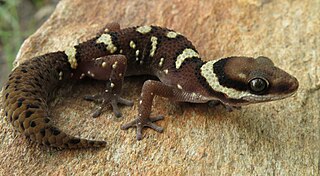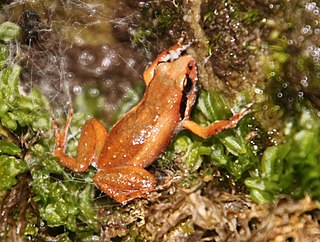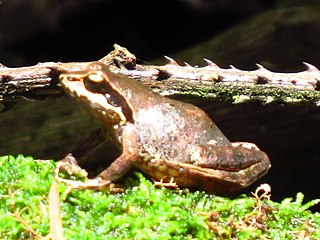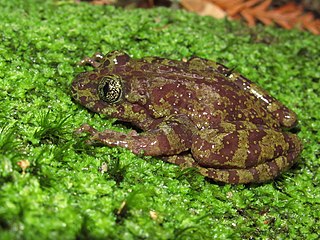
Pachydactylus is a genus of insectivorous geckos, lizards in the family Gekkonidae. The genus is endemic to Africa, and member species are commonly known as thick-toed geckos. The genus also displays rich speciation, having 57 distinct species identified when compared to other closely related gecko genera like Rhoptropus, most of which have emerged since 35Ma. It has been suggested that the reason for this rich speciation not from adaptive radiation nor nonadaptive radiation, but that the genus represents a clade somewhere between the two drivers of speciation. P. bibronii geckos have been used by NASA as animal models for experimentation.

Heleophrynidae is a family of frogs, commonly known as ghost frogs. They are thought to be the most basal group in the Neobatrachia. The family consists of two genera, Heleophryne and Hadromophryne, with seven species. Ghost frogs live in swift-moving mountain streams in South Africa. The common name of "ghost frogs" may have been coined because of their occurrence in Skeleton Gorge.

Capensibufo is a genus of true toads commonly known as Cape toads or mountain toadlets. They are found in the Republic of South Africa from Breede River to north of Knysna, Western Cape Province.

Breviceps is a genus of frogs in the family Brevicipitidae. Species in the genus Breviceps are commonly known as rain frogs or short-headed frogs. They occur in arid to semiarid climates of East Africa and Southern Africa.

The Cape mountain toad or Rose's mountain toad is a species of toad in the family Bufonidae. Other common names include Rose's mountain toadlet, striped mountain toad, Rose's toad, and Muizenberg Cape toad. It is endemic to South Africa, where its natural habitat is Mediterranean-type shrubby vegetation known as fynbos. It is threatened by habitat loss.

Arthroleptella is a genus of frogs known as moss frogs in the family Pyxicephalidae. The ten species of this genus are endemic to South Africa.

Hewitt's moss frog, also known as Natal chirping frog or yellow bandit frog, is a species of frog in the family Pyxicephalidae. It is found in the Drakensberg mountains of South Africa, possibly including adjacent Lesotho.

Cacosternum is a genus of frog in the family Pyxicephalidae that are found in southern and eastern Africa. They have many common names, including cacos, dainty frogs, and metal frogs.
The Hewitt's ghost frog is a species of frog in the family Heleophrynidae. It is endemic to Eastern Cape Province, South Africa. Its natural habitat is fynbos heathland and grassy fynbos. Adults are difficult to see but live in or near fast-flowing perennial rivers and streams where they also breed. Each female lays up to 200 eggs. Tadpoles are more readily seen and take two years to develop fully.

The eastern ghost frog is a species of frog in the family Heleophrynidae.

The Purcell's ghost frog is a species of frog in the family Heleophrynidae. It is endemic to Western Cape Province, South Africa. Its natural habitat is fynbos heathland. Breeding takes place in perennial streams. Their tadpoles take two years to develop fully.

The royal ghost frog, also known as the southern ghost frog or Cape ghost frog, is a species of frog in the family Heleophrynidae. It is endemic to South Africa, and lives in fast-moving streams.

Rose's ghost frog, or Table Mountain ghost frog, is a species of frog in the family Heleophrynidae endemic to South Africa. It is a medium-sized species with purple or brown blotches on a pale green background and large discs on its fingers and toes. It has a very restricted range, being only known from the slopes of parts of Table Mountain. The tadpoles live in permanent streams but these are in danger of drying up because of the establishment of pine plantations. Because of its small range and changes in its habitat, this frog is listed as critically endangered by the International Union for Conservation of Nature.

The Chile Darwin's frog, also called the northern Darwin's frog, is one of only two members of the family Rhinodermatidae. It is endemic to central Chile, although it might well be extinct.

The Biodiversity of Cape Town is the variety and variability of life within the geographical extent of the City of Cape Town metropolitan municipality, excluding the Prince Edward Islands. The terrestrial vegetation is particularly diverse and much of it is endemic to the city and its vicinity. Terrestrial and freshwater animal life is heavily impacted by urban development and habitat degradation. Marine life of the waters immediately adjacent to the city along the Cape Peninsula and in False Bay is also diverse, and while also impacted by human activity, the habitats are relatively intact.

Anhydrophryne is a genus of frogs in the family Pyxicephalidae, formerly in Petropedetidae. It is endemic to South Africa. Until recently, the genus was monotypic, containing only Anhydrophryne rattrayi, until it absorbed two more species formerly classified as belonging to genus Arthroleptella.
Vivian Frederick Maynard FitzSimons, born in Pietermaritzburg, was a notable herpetologist in South Africa. Also, he contributed to the collection of spermatophyte samples for the National Herbarium which has become part of the South African National Biodiversity Institute at the Pretoria National Botanical Garden. In 1937, together with Anna Amelia Obermeyer, he collected some of the earliest plant specimens from the Eastern Highlands of Rhodesia.
Caesetius is a genus of spiders in the family Zodariidae. It was first described in 1893 by Simon. As of 2017, it contains 10 species from southern Africa.

Namazonurus, is a genus of lizards, commonly known as Namaqua girdled lizards, in the family Cordylidae. The genus contains five species, which are endemic to southern Africa, and feed on insects and small vertebrates.

















